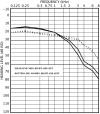Hearing impairment is common among Saami adults in Northern Finland
- PMID: 29132251
- PMCID: PMC5700497
- DOI: 10.1080/22423982.2017.1398004
Hearing impairment is common among Saami adults in Northern Finland
Abstract
The Saami are the only indigenous population in Europe and their traditional living area is northern Scandinavia. Hearing impairment (HI) among Saami has not been studied before. The objective was to investigate the presence and type of HI among Saami adults, aged 49-77 years (median age 61 years), living in northern Finland. In addition, the presence of self-reported hearing difficulties, difficulties to hear in background noise and tinnitus were studied. An epidemiological, cross-sectional study encompassing a structured interview, otological examination and audiometry was performed. Bilateral HI was present in 42.9% of men and 29.4% of women, when HI was defined as a pure tone average (PTA) of at least 20 dB hearing level (HL) or more at the frequencies of 0.5, 1, 2 and 4 kHz. In one or both ears (worse ear hearing level, WEHL0.5,1,2,4≥20 dB HL) HI was present in 61.8% of men and 42.2% of women. Sensorineural high frequency hearing impairment was found to be most common. Nearly half (46.9%) of the study subjects reported hearing problems and more than half (55.6%) reported difficulties in following conversation in background noise. Measured HI and subjective hearing difficulties are common among the Saami adults. The healthcare personnel working in this area should be aware of the hearing problems of the Saami population.
Abbreviations: ARHI, Age-related hearing impairment; PTA, Pure tone average; HI, Hearing impairment; HL, Hearing level; BEHL, Better ear hearing level; WEHL, Worse ear hearing level; CI, Confidence interval.
Keywords: Hearing loss; Saami; adult; indigenous.
Conflict of interest statement
No potential conflict of interest was reported by the authors.
Figures
References
-
- Norio R. Finnish disease heritage II: population prehistory and genetic roots of Finns. Hum Genet. 2003;112:457–469. - PubMed
MeSH terms
LinkOut - more resources
Full Text Sources
Other Literature Sources
Miscellaneous


